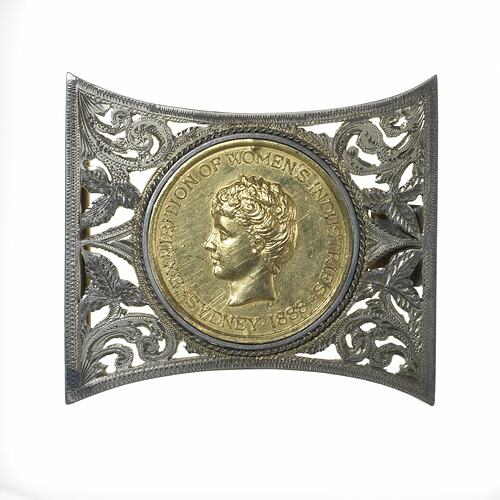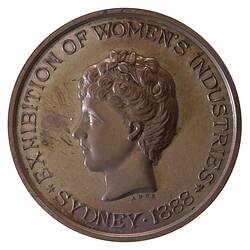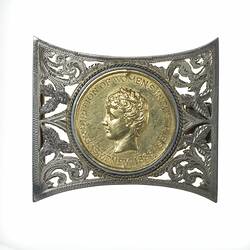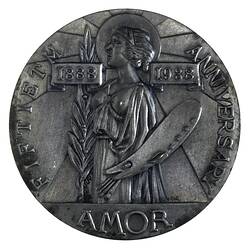Summary
Medal mounted in belt buckle. One of three gold prize medals awarded by a sponsor at the Women's Industrial Exhibition (the Exhibition of Women's Industries and Centenary Fair) in New South Wales in 1888. Sponsored by Mrs Hunter-Baillie, it was won by Ellen Julia (Nellie) Gould in the sick nursing and ambulance work prize department. Gould was a nurse at Royal Prince Alfred Hospital, Sydney and later matron and superintendent of the training school at Sydney Hospital. She also served during World War I, at one stage as Matron of Harefield House Hospital (No. 1 Australian Auxilliary Hospital) in Middlesex, England.
Nellie had this medal, one of only 10 gold medals known to have been awarded at the Exhibition, mounted in a gilt belt buckle.
The Exhibition was organised by philanthropist and suffrage campaigner Lady Mary Elizabeth (Bolton) Windeyer (1836 - 1912) and presided over by Lady Cecilia Carrington, wife of the NSW Governor. Proceeds from a sale of the work exhibited financed the Temporary Aid Society, which provided assistance to women in financial difficulty. The Exhibition comprised seven competitive departments: needlework and lace, knitting, domestic industries (cooking and confectionary), mechanical work (typewriting, box and toy making), educational (especially sick nursing and ambulance work), horticulture and floriculture and fine arts (paintings, drawings, photography and pottery). The Exhibition's motto was 'Patience, Work and God's Grace'. It included a series of auctions, cooking demonstrations, lectures on food and temperance, concerts of singing and other music, dramatic performances, comedies and award ceremonies. The Exhibition opened on Tuesday 2 October, with a ceremony performed by Lady Carrington. A 100-voice choir sang, accompanied by the Permanent Artillary Band. The Exhibition received considerable praise. It was free to children, although too expensive for working class women who also faced a rail fare to the venue. One newspaper correspondent commented that women touted their wares at the exhibition as if it was a common flea market. Nevertheless, it drew close to 3,000 people each day, and its nett profit of 6,000 pounds financed the Temporary Aid Society, which provided assistance to women in financial difficulty. Competitive prize medals were struck by W.J. Amor in gold, silver and bronze. About 15 gold, and 250 each of silver and bronze were struck.
Physical Description
The medal features a profile portrait of a young woman facing left (obverse) and the New South Wales badge (reverse): the cross of St George in red (indicated by vertical stripes) on a white disc, at the extremity of each arm of the cross is an eight pointed star, and in the centre of the cross is a lion passant guardant set within a wreath of Australian native flowers; it is set in an ornate gilt buckle on a swivel mount.
Obverse Description
Medal set in ornate belt buckle. At centre of medal a profile portrait of a young woman facing left; around, EXHIBITION OF WOMEN'S INDUSTRIES * SYDNEY . 1888 * ; the artist's and mint name AMOR under neck truncation.
Reverse Description
At centre within a wreath of Australian native flowers, the New South Wales badge, the cross of St George in red (indicated by vertical stripes) on a white disc, at the extremity of each arm of the cross is an eight pointed star, and in the centre of the cross is a lion passant guardant; around PATIENCE, WORK AND GOD'S GRACE; below in tiny letters, AMOR. SYDNEY
Edge Description
Inscribed, NELLIE GOULD [NU]RSING DEPARTMENT.
Significance
In 1888 Lady Barrington presided over the Exhibition of Women's Industries in Sydney, held during October at Prince Albert Park, Redfern, housed in the 1870 Intercolonial Exhibition Building (demolished 1954). The Exhibition was the closing event in centenary celebrations. Lady Barrington formed a committee that elected her president; she also formed other organizational committees. She was depicted on the prize-winners' medal. Lady Mary Elizabeth (Bolton) Windeyer (1836 - 1912) was a principle organiser. She was a philanthropist and charity worker, and Foundation President of the Womanhood Suffrage League of New South Wales.
The Exhibition was structured with Patrons, including the Governor, Chief Justice and Sir Henry Parkes. The seven competitive departments within the Exhibition were each open to school pupils, girls and women of all backgrounds. The departments comprised needlework and lace, knitting, domestic industries (cooking and confectionary), mechanical work (typewriting, box and toy making), educational (especially sick nursing and ambulance work), horticulture and floriculture and fine arts (paintings, drawings, photography and pottery). Each department and an assigned delegate. Lady Carrington was delegate for horticulture and floriculture.
The Exhibition's motto was 'Patience, Work and God's Grace'. It included a series of auctions, cooking demonstrations, lectures on food and temperance, concerts of singing and other music, dramatic performances, comedies and award ceremonies.
The Exhibition opened on Tuesday 2 October, with a ceremony performed by Lady Carrington. A 100-voice choir sang, accompanied by the Permanent Artillary Band.
The Exhibition received considerable praise. It was free to children, although too expensive for working class women who also faced a rail fare to the venue. One newspaper correspondent commented that women touted their wares at the exhibition as if it was a common flea market. Nevertheless, it drew close to 3,000 people each day, and its nett profit of 6,000 pounds financed the Temporary Aid Society, which lent money to women in financial difficulty. Competitive prize medals were struck by W.J. Amor in gold, silver and bronze. About 15 gold, and 250 each of silver and bronze were struck. -Smith, R. A. 1997. Sydney Women's Exhibition Medal. Australian Coin Review; Australian Dictionary of Biography. -D. Tout-Smith 17/11/2003.
More Information
-
Collecting Areas
-
Acquisition Information
Purchase from Spink (Australia), 31 May 1990
-
Date Issued
1888 AD
-
Issued By
Exhibition of Women's Industries, Sydney, Greater Sydney, New South Wales, Australia, 1888
-
Mint
Amor (Mint), Sydney, Greater Sydney, New South Wales, Australia, 1888
This was the first medal struck by W.J. Amor, Sydney, according to Carlisle, p.56. -
Commissioned By
Exhibition of Women's Industries, Sydney, Greater Sydney, New South Wales, Australia, 1888
-
Organiser of Event
-
Person Depicted
Lady Cecilia Annetta Carrington, New South Wales, Australia, 1888
-
Awarded To
Nurse Ellen (Nellie) J. Gould - Royal Prince Alfred Hospital, Sydney, Greater Sydney, New South Wales, Australia, 1888
One of three gold medals awarded -
Inscriptions
Inscribed: "NELLIE GOULD [NU]RSING DEPARTMENT" (edge, obscured by buckle mount) "EXHIBITION OF WOMEN'S INDUSTRIES / SYDNEY.1888", "AMOR" under neck truncation (obverse) "PATIENCE, WORK AND GOD'S GRACE/AMOR. SYDNEY" (reverse)
-
Series
-
Material
Gold
-
Axis
12
-
Classification
-
Category
-
Discipline
-
Type of item
-
Dimensions
72 mm (Width), 63 mm (Height), 79.92 g (Weight)
-
Exhibition Collection Management
72 mm (Length), 63 mm (Width)
-
Object Dimensions
71 mm (Width), 6 mm (Depth), 64 mm (Height)
-
Shape
Irregular
-
References
Car 1888/14 Ruth Rae, 2006. 'Ellen Julia Gould: a civilian nurse and founder of the military nursing tradition in Australia (1860-1941)'. Journal of the Royal Australian Historical Society, December 1 2006 - see [Link 1] Photograph of Ellen Gould in the Australian War Memorial collection: ID Number A01156, c 1915: an outdoor portrait of Principal Matron Ellen Julia Gould, No 1 Australian Auxiliary Hospital (AAH)
[Article] Smith, R. A. 1997. Sydney Women's Exhibition Medal. Australian Coin Review. (392)
[Book] Carlisle, Leslie J. 1983. Australian commemorative medals and medalets from 1788.
-
Keywords
Exhibitions, Gold, Healthcare & Medicine, Nursing, Wars & Conflicts, Women's Work, World War I, 1914-1918




